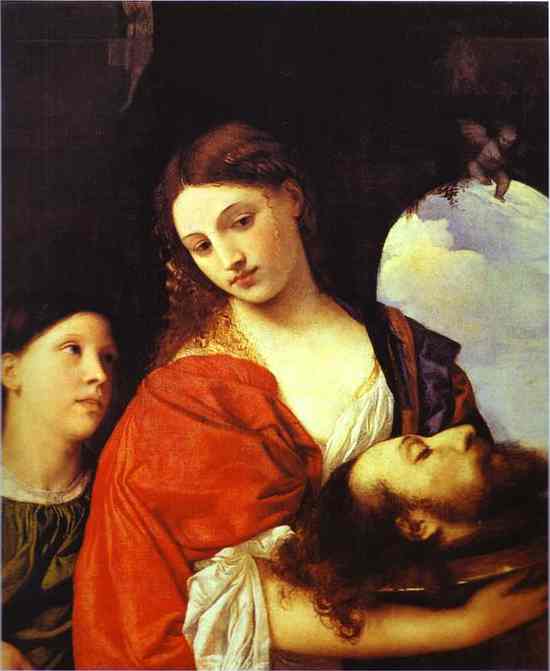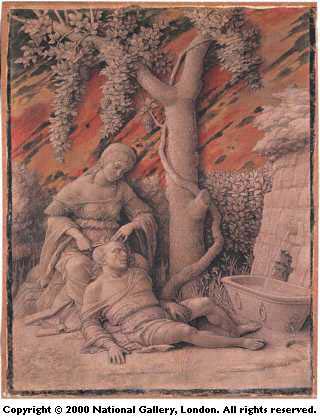EDITED EXCERPTS FROM: H. Diane Russell, Eva/Ave: Women in Renaissance and Baroque Prints (Washington, D.C.: National Gallery of Art, 1990), pages 147, 149
Images of the "Power of Women" sometimes showed men subjected to the ridicule of others. Such was the case when the famed poet Virgil, trying to reach a woman's room by being pulled up to it in a basket, was left by her to dangle helplessly. The next morning, a crowd gathered and made fun of his plight.

Lucas van Leiden
Virgil Suspended in a Basket, engraving, 1525
The consequences could be much more serious, however. The influence of Herodias and her daughter Salome upon Herod resulted in the decapitation of John the Baptist.

Cesare da Sesto
Salome with the Head of St. John the Baptist
Oil on wood, c. 1510-1520. (National Gallery, London)

Titian
Salome with the Head of St. John the Baptist
Oil on canvas, 1515. (Galleria Doria Pamphilj, Rome)
In a similar way, Samson was lured by the sexual appeal of Delilah to drink too much and to reveal to her that the secret of his vaunted physical strength was his hair. When he fell asleep in her lap, she cut his hair off, and he was captured by his enemies, the Philistines, who had paid her to entrap him.

Andrea Mantegna, Samson and Delilah
c. 1500. (National Gallery, London)
In most of these stories, the women tempt the men with their sexual attractiveness in order to triumph over them.
A popular subject illustrating the Power of Women topos is the image of Phyllis riding Aristotle.

Hans Baldung Grien
Aristotle and Phyllis, woodcut, 1510
It shows the much venerated ancient philosopher, Aristotle, having succumbed to his lust for the beautiful Phyllis, usually said to be Alexander the Great's wife or mistress. According to a common version of the legend, Aristotle had earlier warned Alexander, his pupil, that the young man was paying too much attention to this woman. When the philosopher approached Phyllis with his own desires, she insisted, before she agreed to gratify them, that Aristotle put on a bridle and let her ride on his back around the garden. This he did, and Alexander and a companion is shown looking on. The basic moral of the story is quite clear: even so rational and learned a man as Aristotle can allow his desire for a woman to overcome his reason; he is thus reduced to behaving as beasts do.

